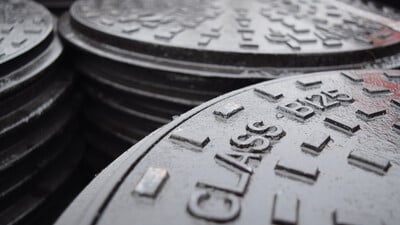BS EN 124 is the definitive European standard for access covers and gratings installed in areas trafficked by vehicles or pedestrians. From busy roads and industrial yards to domestic driveways and public footpaths, it provides a structured and reliable framework for determining what strength and specification of cover is suitable for a given environment.
Despite its critical role in public infrastructure, BS EN 124 is not widely understood outside of specialist engineering and civil works circles. Yet the consequences of selecting the wrong product – both in terms of safety and long-term cost – can be considerable. In this article, we explore the purpose of the standard, the various load classifications it defines, and how to ensure the products you specify or install are truly compliant. We'll also look at how suppliers such as Drainfast ensure their range of access covers and drainage products meet these vital standards.
The Role of BS EN 124
At its core, BS EN 124 is about safety, reliability and clarity. It governs the design, manufacture and performance of gully gratings and manhole covers intended for installation in trafficked areas. Whether made from cast iron, steel, composite materials or concrete, these products must perform consistently under load and resist environmental stresses such as frost, corrosion and fatigue. BS EN 124 ensures these criteria are met and documented, with clearly defined test methods and classification markings.
BS EN 124 was first introduced in 1994 as a way of standardising products across European countries. Its most recent version, BS EN 124:2015, offers an even more detailed approach by splitting the standard into six parts according to the material used and the intended environment. It replaces outdated local standards (such as BS 497 in the UK) and brings together years of technical development into one harmonised framework.
Why it Matters in Practice
Choosing a cover that isn’t fit for its location can lead to disastrous outcomes. Whether it’s a failure under traffic load or the risk of pedestrian injury, these are scenarios that every local authority, contractor and civil engineer seeks to avoid. BS EN 124 provides a dependable reference point to minimise those risks. A product that meets this standard will have been tested to withstand specific loads, certified by a recognised third party, and marked to show clear traceability back to the manufacturer.
In addition to peace of mind, compliance also brings accountability. If something goes wrong, having used BS EN 124-certified products demonstrates that correct procedures were followed. Increasingly, public sector contracts and utility company specifications require adherence to this standard, and any deviation could void warranties, invalidate insurance, or incur legal liability.
Understanding the BS EN 124 Load Classes
One of the most critical features of the standard is the classification system. BS EN 124 divides access covers and gratings into six classes, ranging from A15 to F900. These classes are determined by the maximum load the product must withstand under testing, and each class corresponds to a different type of environment and traffic use.
Class A15
This covers the lightest duty applications. It is designed for areas used solely by pedestrians or cyclists, such as garden paths, private patios or public green spaces where no vehicle access is expected. These covers are not suitable for even occasional vehicle traffic and would quickly deform or fail if subjected to more than their intended load.
Class B125
This is the next step up and is suitable for light-duty traffic. You’ll typically find this class in driveways, car parks that only accommodate private cars, or on pedestrian zones where small maintenance vehicles may occasionally pass. Though more robust than A15, they are still not designed for roads or areas where larger vehicles are present.
Class C250
This classification is intended for products used in the kerbside channel of a road, where they may be traversed by lighter vehicles but not subject to continuous loading by heavy goods vehicles. Examples include estate roads, retail parks and areas adjacent to but not directly on a carriageway.
Class D400
This class is required for covers and gratings installed in the main carriageway of roads, including hard shoulders, lay-bys and access roads to industrial sites. Designed to withstand a 400kN test load, these products are essential for any installation exposed to regular HGV traffic.
Class E600
Ports, freight terminals, and aircraft pavements where the loading can be intense, repetitive and unpredictable typically demand Class E600 products. The increased strength requirements help these covers withstand the stress of very high axle weights and large surface pressures.
Class F900
At the top of the spectrum is Class F900, which is required for extreme-duty applications such as airport runways, military airfields, and other heavily trafficked specialist sites. Products in this class must be able to withstand the heaviest vehicular loads without deformation or failure, and are often specially engineered with high-performance materials.
How BS EN 124 is Applied to Manufacturing
Meeting the load-bearing threshold is only one aspect of BS EN 124 compliance. The standard sets strict requirements for marking, traceability and quality assurance. Each product must display permanent markings that clearly indicate the BS EN 124 reference, the appropriate class (e.g., D400), the manufacturer’s identification, and the place of manufacture. These markings allow for full traceability in the event of an inspection, failure or audit.
How BS EN 124 Certification is Achieved
Certification is typically carried out by third-party bodies such as the British Standards Institution (BSI), which offers Kitemark certification to manufacturers whose products meet the required performance levels and undergo regular testing. The standard also mandates quality control procedures at every stage of manufacture to ensure consistency across batches, along with material performance requirements such as resistance to corrosion, fatigue and temperature variation.
BS EN 124: One Standard for Many Materials
It’s also worth noting that BS EN 124 is split into six parts, each dealing with a specific material or component: from ductile iron (Part 2) to composite materials (Part 5) and reinforced concrete (Part 4). This modular structure ensures that the testing methods and durability expectations are appropriate to the specific characteristics of the material used.
How BS EN 124 Aligns with UK Regulation
While BS EN 124 is not statutory law, it is deeply embedded in regulatory and contractual frameworks across the UK. Government guidance documents, such as the Manual for Streets and the Design Manual for Roads and Bridges (DMRB), regularly reference BS EN 124 as the basis for selecting compliant covers and gratings. Building Regulations also align with the standard, particularly in Part H, which governs drainage and waste disposal.
Local authorities and utility companies often require BS EN 124-compliant products for any installation that will be adopted into the public network. This means that compliance is effectively mandatory for any new-build road, sewer, or utility infrastructure that will eventually become public property. Even in private developments, consultants and contractors will usually specify BS EN 124 classes as part of best practice or insurance obligations.
BS EN 124-Compliant Products from Drainfast
Drainfast is one of the UK’s most trusted suppliers of drainage systems and associated civil engineering products. Our range of manhole covers, gully gratings and access covers includes a broad spectrum of BS EN 124-compliant options. Whether you are working on a domestic driveway or a trunk road redevelopment, Drainfast provides covers in all standard load classes, from B125 to F900, including recessed options for block paving, sealed covers for foul water systems, and specialist security-rated products for sensitive installations.
We understand that compliance isn’t just a checkbox – it’s a safeguard against failure, a legal assurance, and a commitment to building robust, long-lasting infrastructure. That’s why we provide certified products with full documentation and test data, and offer expert technical advice to ensure clients select the right class for every project.
BS EN 124 Compliance: Why Expert Support is Vital
Specifying the correct load class requires an understanding of the environment, present and future traffic loads, and the expectations of clients, regulators and insurers. A cover installed in the wrong place – no matter how high-quality it may be – can become a safety hazard or financial liability. Conversely, over-specifying may waste valuable budget.
The most effective way to make the right choice is to work with a knowledgeable supplier and ensure that every product is not only certified but also matched precisely to the demands of its location. In doing so, you protect not only the people and vehicles that will pass over it, but also your project timeline, reputation and long-term costs.
For more information, expert advice and technical support, call our friendly team on 01420 555600.
Product Links
- Drainfast Manhole Covers and Frames - https://www.drainfast.co.uk/products/underground/manhole-covers-frames
- Drainfast Ductile Iron Gully Gratings - https://www.drainfast.co.uk/products/underground/manhole-covers-frames/gully-gratings
Further Reading
- Introducing BS EN 124:2015: Gully tops and manhole tops for vehicular and pedestrian areas, BSI Standards Publication, 2015 – https://www.bsigroup.com/globalassets/localfiles/en-in/product_certification/bs-en-124-2015-gully-tops-and-manhole-tops-for-vehicular-and-pedestrian-areas.pdf
- Designing and modifying residential streets: Manual for streets, Department for Transport and Communities and Local Government, 2007 – https://www.gov.uk/government/publications/manual-for-streets
- Welcome to the DMRB, National Highways – https://www.standardsforhighways.co.uk/dmrb/
- BSI Kitemark Certification for Manhole Covers, British Standards Institution – https://www.bsigroup.com/LocalFiles/en-GB/product-certification/Construction/BS-EN-124-Update-UK-EN.pdf

Written by
Bob Stone
Technical Sales
Heading up our Technical Estimating Department, Bob is our in-house quantity surveyor.

